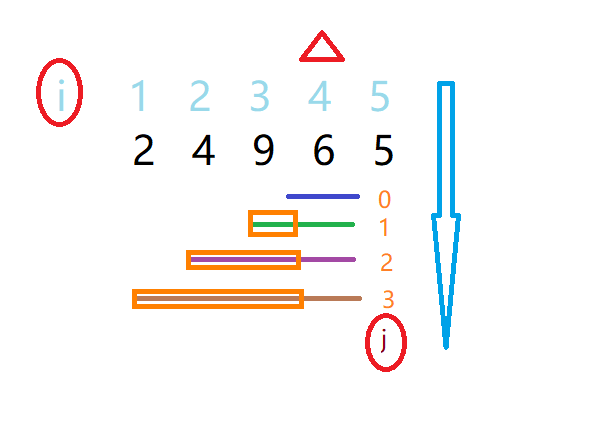树状数组。。。
Different GCD Subarray Query
Time Limit: 6000/3000 MS (Java/Others) Memory Limit: 65536/65536 K (Java/Others)
Total Submission(s): 1541 Accepted Submission(s): 599
Given an array a of N positive integers a1,a2,⋯aN−1,aN; a subarray of a is defined as a continuous interval between a1 and aN. In other words, ai,ai+1,⋯,aj−1,aj is a subarray of a, for 1≤i≤j≤N. For a query in the form (L,R), tell the number of different GCDs contributed by all subarrays of the interval [L,R].
For each test, the first line consists of two integers N and Q, denoting the length of the array and the number of queries, respectively. N positive integers are listed in the second line, followed by Q lines each containing two integers L,R for a query.
You can assume that
1≤N,Q≤100000
1≤ai≤1000000
这个题的意思就是问区间内所有子段不同gcd的个数。
一开始理解错了题意,后来想明白了。假设区间的数为1 2 3 4
就是gcd(1),gcd(2),gcd(3),gcd(4),gcd(1,2),gcd(2,3),gcd(3,4),gcd(1,2,3),gcd(2,3,4),gcd(1,2,3,4)这些里面不同的gcd的个数是多少。
如果用在线算法操作,每查询一次就要处理依次数据,一方面会造成浪费,另一方面,你这样写妥妥的超时啊,所以要用离线算法,将所有的数据处理好之后,按顺序直接输出结果就可以。
首先用一个数组将数据保存起来,然后用一个vector数组将查询的区间和查询的顺序记录下来。
处理数据,就是相对来说固定右端点,从右往左移,在代码里就是对于每一个i(固定右端点),遍历一下i所在的子段的gcd,因为i不变,j是上一个i的gcd的值保存的顺序,j越大,i所在的子段就依次向左增加一个数,如果gcd发生了变化,就记录一下这个gcd以及出现的位置。可能越说越乱,画一个图表示一下。。。

图的意思就是假设数据为2 4 9 6 5,i为下标。假设i为4,就是固定4,然后遍历j,j存的是上一个i的子段的gcd,通过上一个i的gcd来得到i为4时(6)的子段的gcd,图中画的横线的长度就是子段的长度,橙色的矩形包含的长度是上一个i处理出的数据。就是固定右端点,依次往左遍历得到所有的gcd,这样不会重复操作,也不会漏掉某个子段。
将gcd整理出来之后,怎么操作才能使得区间查询的是不同的gcd的个数呢?
对于区间内相同的gcd,让标记gcd的下标尽量右移,找该gcd的最大右端点。
通过树状数组维护gcd的下标。
一边维护,一边查询树状数组就可以保证数据正确。
总结一下就是:固定右端点,依次往左找出来所有的gcd,并标记下标,因为是i逐渐增大的,所以后面遍历的时候也是相同gcd的最大右端点。直接查询就可以。
就这样吧,不想好好写了。
代码:
1 //离线处理-树状数组 2 #include<iostream> 3 #include<cstring> 4 #include<cstdio> 5 #include<cmath> 6 #include<cstdlib> 7 #include<algorithm> 8 #include<queue> 9 #include<vector> 10 #include<utility> 11 using namespace std; 12 const int maxn=1e5+10; 13 int Arr[maxn];//存数据一开始的值 14 int N,Q; 15 int pos[maxn*10]; //记录gcd的位置 16 vector<pair<int ,int> >querys[maxn]; 17 vector<pair<int, int> >gcds[maxn]; 18 int ans[maxn]; 19 int treeArr[maxn]; //树状数组 20 21 int gcd(int a,int b){ //gcd求最大公约数 22 if(!(a%b))return b; 23 else return gcd(b,a%b); 24 } 25 26 void init(){ //初始化 27 int tmp,ts; 28 for(int i=1;i<=N;i++){ 29 tmp=Arr[i]; 30 ts=i; //固定右端点,向左遍历 31 for(int j=0;j<gcds[i-1].size();j++){ 32 int tmpgcd=gcd(tmp,gcds[i-1][j].first); 33 if(tmpgcd!=tmp){ //如果gcd发生变化 34 gcds[i].push_back(make_pair(tmp,ts)); //first存gcd,second存gcd的左端点ts 35 ts=gcds[i-1][j].second; //上一个gcd的右端点就是下一个gcd的左端点 36 tmp=tmpgcd; 37 } 38 } 39 gcds[i].push_back(make_pair(tmp,ts)); //将与上一个的最左端的gcd存起来 40 } 41 return; 42 } 43 44 int lowbit(int x){ //取最低位的1 45 return x&(-x); 46 } 47 48 void Add(int cur,int num){ //单点更新 49 for(int i=cur;i<=N;i+=lowbit(i)) 50 treeArr[i]+=num; //由叶子节点向上更新树状数组 51 return; 52 } 53 54 int Query(int cur){ //区间查询 从右端点往左加二进制最低位1的 55 int sum=0; 56 for(int i=cur;i>0;i-=lowbit(i)) 57 sum+=treeArr[i]; 58 return sum; 59 } 60 61 void Solve(){ 62 memset(pos,0,sizeof(pos)); 63 memset(treeArr,0,sizeof(treeArr)); 64 for(int i=1;i<=N;i++){ 65 for(int j=0;j<gcds[i].size();j++){ 66 if(pos[gcds[i][j].first]){ //如果标记已经存在,就将标记去掉,所以执行单点更新操作 67 Add(pos[gcds[i][j].first],-1); 68 } 69 Add(gcds[i][j].second,1);//一个新的不同的gcd,从叶子节点开始更新个数+1 70 pos[gcds[i][j].first]=gcds[i][j].second;//记录该gcd的右端点 71 } 72 for(int j=0;j<querys[i].size();j++){ 73 ans[querys[i][j].second]=Query(i)-Query(querys[i][j].first-1);//区间右端点-区间左区间 74 } 75 } 76 for(int i=1;i<=Q;i++) 77 printf("%d ",ans[i]); 78 79 return; 80 } 81 int main(){ 82 //reopen("input","r",stdin); 83 while(~scanf("%d%d",&N,&Q)){ 84 for(int i=1;i<=N;i++){ 85 scanf("%d",&Arr[i]); //将数据存在Arr数组中 86 querys[i].clear(); //清空 87 gcds[i].clear(); //清空 88 } 89 init(); 90 int tmp1,tmp2; 91 for(int i=1;i<=Q;i++){ 92 scanf("%d%d",&tmp1,&tmp2); 93 querys[tmp2].push_back(make_pair(tmp1,i)); //将tmp1与i成对插入vector的tmp2下标里 94 } 95 Solve(); 96 } 97 return 0; 98 }
就这样吧,这题没什么,主要是想明白就很简单。
咸鱼太菜,学长要捶爆我的狗头吗???
已经做好了被学长打死的思想准备。。。